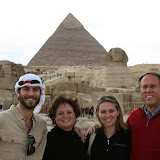We visited Cairo both at the beginning and end of our Egypt trip. While the Pyramids and King Tut's tomb at the museum were both fascinating, the poverty and chaos of the city were really shocking.
Daniel
For photos, click here.
 |
| Cairo |
Cairo is the largest city in Africa with around 16 million inhabitants. Driving in from the airport was a great way to see how huge and populous this metropolis is. Sadly, this is also one of the most polluted cities/areas in Africa. We basically did Cairo in two trips, which acted as the bookends to our overall Egypt trip.
During our first stay we visited Memphis the site of Djoser's Step Pyramid in (an hour drive south of Cairo). Djoser, a powerful Pharaoh around 2600 BC, initiated the Ancient Egyptian obsession with the Pyramid. Memphis also had a few interesting relics. Not surprisingly, one of the ancient temple sites has a Ramses II statue on display. The statue (one of three) is made of alabaster and stands almost 15 ft tall. Like I said earlier this guy left his mark on Egypt.
Later we drove to Giza for the Great Pyramids. They absolutely dwarf Djoser's Pyramid but owe all their grandeur & genius to his initial works. To be honest, they are hard to really appreciate in person. The scale is so enormous that they just seem like geometric mountains poking out of the dessert. Standing at the base of one of the Pyramid corner stones - I couldn't imagine how these stones were so tightly stacked in an effort to reach to the sun. It's interesting that even today there are numerous theories on how the Egyptians most likely constructed the Pyramids.
While at Giza we climbed into the heart of the Great Pyramid and scrambled up the narrow and stuffy chambers only to arrive to a small and stuffy inner chamber that is believed to be a false treasure room. We also took a short camel ride on the Pyramid grounds - it was pretty corny but made for some great photos! Click here for a video of Kim attempting to dismount her camel...but it didn't want her to get off!
The highlight of our day in Giza was the Solar Boat. We didn't even know about this amazing archaeological find before we arrived at the more well-known Pyramids and Sphinx. The Solarboat Museum at the base of the Pyramid of Cheops in Egypt contains the actual, reconstructed boat that was used in the funerary ceremonies of the Pharaoh Cheops. It was amazing to imagine the construction of this ceremonial boat in ~2500 BC! And to think that it has lasted 4000 years and is still perfectly preserved! (The boat wasn't discovered until after WWII.)
Finally, there was the Sphinx. What I remember most about the Sphinx, sadly, is staring at KFC and Pizza Hut that were built only 100ft from the site. The sole path leading up to a closer view of the Sphinx is packed with locals trying to sell kitchy souvenirs etc. It feels like Giza and Cairo are slowly creeping into and over the ancient sites.
On our return trip to Cairo we visited the newly built Cairo Museum, which holds a ton of cool artifacts. The highlights are definitely Tutankhamun's treasure and many, many mummies. The riches of Tutankhamun's burial chamber are amazing. Most famous is the funerary mask that absolutely glows - pure gold and mostly inlaid with lapis lazuli. Also, there was another entire wing dedicated to the various artifacts found inside the burial chamber ranging from model ships, chariots, to small figurines representing all the labourers/servants involved in the construction of his tomb.
We spent time wandering the lesser known Coptic area in Cairo. This neighborhood is dominated by Coptic Churches. The Coptic Church split with Eastern Orthodox and Catholic churches, which were still joined. It was interesting to see how much a region/culture can influences the traditions of the church. In a number of the churches the current Coptic Pope was prominently pictured. If I wasn't sure about being in a church I would have mistaken him for a Imam or Islamic religious leader.
Finally, we spent quite a bit of time at the Cairo Bazaar - highly recommended as one of the "must see" things in Cairo. There was something about the stench and large amounts of garbage that made us wonder what the "bad" parts of Cairo were like. While in the Bazaar we often had to tip toe through passageways covered with layers of garbage and mud. Although the smell and pollution were in our face - we did find some great Egyptian food at one of the restaurants buried in the maze of alleys within the Bazaar. Click here for a video of the evening call to prayer in the heart of Islamic Cairo.
Cairo was great to visit for a day or two, but you don't need to spend more time here. Time in Egypt is much more well spent along the Nile and near Luxor. The ancient sites are more impressive and less overrun with urban sprawl.
No comments:
Post a Comment